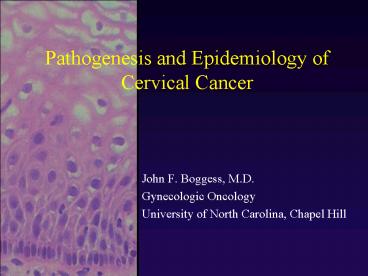Pathogenesis and Epidemiology of Cervical Cancer - PowerPoint PPT Presentation
1 / 45
Title: Pathogenesis and Epidemiology of Cervical Cancer
1
Pathogenesis and Epidemiology of Cervical Cancer
- John F. Boggess, M.D.
- Gynecologic Oncology
- University of North Carolina, Chapel Hill
2
Cervical Cancer Facts
- Second leading cause of cancer death worldwide
- Bimodal age distribution
- Risk factors include age, smoking, number of
sexual partners, STDs (HPV) - Early stages of disease are not symptomatic
3
Incidence United States
- 12,800 new cases per year
- 4,800 annual deaths
- 14.2/100,000 (1973)
- 7.8/100,000 (1994)
CA Cancer J Clin, 1999
4
Cervical Cancer Mortality
- World Wide 14.7-0.6
- (Mexico-Thailand)
- United States 2.7
- North Carolina
- White 2.3
- Non-White 7.2
Rate per 100,00 population
5
Survival by Stage
- Pre-invasive 100
- Localized 91.5
- Distant 12.6
SEER Cancer Statistics, 2000
6
Risk Factors
- Human Papilloma Virus (HPV)
- Sexual Behavior
- Early age of first intercourse
- Greater number of lifetime sexual partners
- Cigrarette Smoking
- Race
- Socioeconomic Status
- Family history
7
Are Pap Smears Effective?
- Incidence
- 1940 1991
- 32.6 7.9
76
Hoskins, Principles and Practices of Gynecologic
Oncology
8
Cervical Anatomy
9
(No Transcript)
10
Bethesda System
- Benign Reactive Changes
- Squamous Intra-epithelial Lesion
- Low Grade (LGSIL)
- High Grade (HGSIL)
- Carcinoma
- Atypical Cells of Undetermined Significance
(ASCUS)
11
Classification Systems
12
Colposcopic Findings
13
Condyloma Accuminata
14
Condyloma
15
3 Acetic Acid Reaction
16
Mosaicism Punctation
17
Cervical Dysplasia
18
Invasive Cervical Cancer
19
Invasive Cervical Cancer
20
Objectives of Universal Screening
- Decrease cervical cancer deaths
- Intervene when conservative measures can effect a
cure - Identify women at risk and provide education
21
Natural History of CIN I
- Regression 60
- Persistence 30
- Progression 10
Ostor, 1993
22
Pap/Biopsy Correlation
Biopsy
- Normal LGSIL HGSIL
- ASCUS 45 46 9
- LGSIL 38 47 16
- HGSIL 7 18 75
23
Clinical Dilemma
- Abnormal Paps 2.5 Million
Invasive 0.3
Pre-Invasive 4.4
24
Question ?
- How can clinicians triage which minimally
abnormal pap smears are worrisome and which are
not?
25
HPV Causes Cervical Cancer
- More than 90 of cervical cancers contain HPV DNA
- HPV also found in precursor lesions
- HPV mRNA found in cervical cancer tissues
indicating that the HPV genome is expressed in
these lesions - Meets epidemeiologic criteria for causal organism
26
- Why dont all women with HPV get cervical cancer?
- Oncogenic risk based upon HPV type
- Immune system keeps progression from occuring
- Other Factors
- Answer The viral life cycle predicts that only
a percentage of infections will result in
clinically significant disease.
27
HPV Virology
Genus A of Papovaviridae family Non-enveloped DNA
virus Icosohedral capsid Over 70 types based
upon DNA homology Genome divided into three
regions URR, Early genes, Late genes High
oncogenic risk 16, 18, 31 Low oncogenic risk 6,
11
28
Fate of HPV Infection
Condyloma Accuminata Cervical
Intra-epithelial Neoplasia Invasive
Cervical Cancer
29
(No Transcript)
30
Cell cycle
G2/M
G2
M
S
G1/S
G1
31
HPV E6 Cell Cycle Control
GO
E6
p53
Ubiquitin Degradation
32
HPV E7 Cell Cycle Control
E7
GO
Rb
E2F
p107
E7
33
(No Transcript)
34
What makes oncogenic HPVoncogenic?
- Binding affinity for p53 and Rb
- Interaction with silent genetic polymorphisms
- Tendency to integrate and deregulate
35
HPV 16 Transfection
Scientific American February 1996
36
Ploidy with passage
37
Telomeres and passage
38
(No Transcript)
39
Summary
- HPV infection begins at the basal cell layer
- Viral replication is facilitated by E6 which
blocks p53 and E7 which blocks Rb - Viral packaging is induced by the superficial,
differentiated cell layers - Integration of viral DNA occurs at basal layers
and deregulates cell cycle, leading to
dedifferentiation - Telomere erosion leads to genetic instability
- Some cells activate telomerase and become
immortalized by this process
40
Screening Interval
- 1-3 years
- Age 18 or onset of intercourse
- At least until age 65
- low risk discretion of physician
- high risk discretion of physician
41
Screening Postmenopausal Women
- Incidence gt41 years 1.0/1000 1 yr
- 1.2/1000 lt3 yr
- 50-64 yrs 1.4/1000 lt3 yr
- gt65 yrs 0.8/1000 lt3 yr
- Ratio CIN 3/Cancer 41 to gt 101
- No prior abnormal smear, incidence for high
grade lesions
42
Screening Post Hysterectomy
- women who have undergone a hystectomy in which
the cervix was removed do not require Pap
testing, unless the hysterectomy was performed
because of cervical cancer or its precursors
USPSTF
43
Screening Failures
- 50-70 of cancers occur in women who are not
screened ever or within 5 years - Among screened women, failures occur do to
- 1. Failure to adequately follow-up screened
abnormalities (22-63) - 2. Rapid progression (50 with 3 year interval)
- 3. Abnormalities missed by screening test
(14-33) - a. sampling error
- b. detection error
44
Screening Tools
- Conventional cytology Pap Smear
- Thin layer cytology Thinprep,Autocyte
- Computerized re-screening Papnet
- Algorithm-based AutoPap
- HPV testing Digene II
45
Conclusions
- Screening is effective
- Not screening is not effective and is the major
cause of cancer death in United States - All systems based upon the Pap smear have a low
sensitivity and rely on repeat screening - New technologies improve sensitivity at the
expense of cost and specificity































